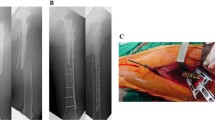Abstract
Fractures of the humeral shaft are a serious and fairly common problem with an incidence expected to triple in the next three decades partly due to an ageing population. These injuries often occur in a bimodal distribution with peaks primarily in young male patients and a larger peak in older females from 60–80 years of age. We present a case of an elderly female patient that describes a rare outcome of bone union in a failed fixation done for a humeral shaft fracture, a situation rarely reported in literature to the best of our knowledge.



Similar content being viewed by others
References
Matsunaga FT, Tamaoki MJ, Matsumoto MH, dos Santos JB, Faloppa F, Belloti JC (2013) Treatment of the humeral shaft fractures—minimally invasive osteosynthesis with bridge plate versus conservative treatment with functional brace: study protocol for a randomised controlled trial. 14(246):1745–6215;1745–6215
Gosler MW, Testroote M, Morrenhof JW, Janzing HM (2012) Surgical versus non-surgical interventions for treating humeral shaft fractures in adults. Cochrane Database Syst Rev 1(CD008832):1361–6137, 1469-493X
Palvanen M, Kannus P, Niemi S, Parkkari J (2006) Update in the epidemiology of proximal humeral fractures. Clin Orthop Relat Res 442:87
Tytherleigh-Strong G, Walls N, McQueen MM (1998) The epidemiology of humeral shaft fractures. J Bone Joint Surg (Br) 802:249–253. doi:10.1302/0301-620X.80B2.8113
Sarmiento A, Kinman P, Galvin E et al (1977) Functional bracing of fractures of the shaft of the humerus. J Bone Joint Surg Am 59:596–601
Zagorski JB, Latta LL, Zych GA et al (1988) Diaphyseal fractures of the humerus. Treatment with prefabricated braces. J Bone Joint Surg Am 70:607–610
Sarmiento A, Zagorski JB, Zych GA et al (2000) Functional bracing for the treatment of fractures of the humeral diaphysis. J Bone Joint Surg Am 82:478–486
Rutgers M, Ring D (2006) Treatment of diaphyseal fractures of the humerus using a functional brace. J Orthop Trauma 20:597–601. doi:10.1097/01.bot.0000249423.48074.82
Denard A, Jr, Richards JE, Obremskey WT, et al. Outcomes of nonoperative vs operative treatment of humeral shaft fractures: a retrospective study of 213 patients. Orthopedics
Idoine JD 3rd, French BG, Opalek JM et al (2012) Plating of acute humeral diaphyseal fractures through an anterior approach in multiple trauma patients. J Orthop Trauma 26:9–18. doi:10.1097/BOT.0b013e318214ebd5
Templeman DC, Sims SA (2007) Humeral shaft fractures. In: Stannard JP, Schmidt AH, Kregor PJ (eds) Surgical treatment of orthopaedic trauma. Thieme Medical Publishers, Inc, New York, pp 263–284
Illert T, Rammelt S, Drewes T, Grass R, Zwipp H (2011) Stability of locking and non-locking plates in an osteoporotic calcaneal fracture model. Foot Ankle Int 32(3):307–313, 1071–1007 (2011 Mar) Publication Date: March 2011, Source: AMED
Hunt KJ, Barr CR, Lindsey DP, Chou LB (2012) Locked versus nonlocked plate fixation for first metatarsophalangeal arthrodesis: a biomechanical investigation. Foot Ankle Int 33(11):984–990, 1071–1007 (2012 Nov) Publication Date: November 2012, Source: AMED
Gondusky JS, Carney J, Erpenbach J, Robertson C, Mahar A, Oka R, Thompson M, Mazurek M (2011) Biomechanical comparison of locking versus nonlocking volar and dorsal T-plates for fixation of dorsally comminuted distal radius fractures. J Orthop Trauma 25(1):44
Miller DL, Goswami T (2007) A review of locking compression plate biomechanics and their advantages as internal fixators in fracture healing. Clin Biomech 22(10):1049–1062, 0266–033 (2007 Dec) Publication Date: December 2007 Source: AMED
Bogunovic L, Cherney SM, Rothermich MA, Gardner MJ (2013) Biomechanical considerations for surgical stabilization of osteoporotic fractures. Orthop Clin N Am 44(2):183–200, 0030–5898 (2013 Apr) Publication Date: April 2013 Source: AMED
Kim T, Ayturk UM, Haskell A, Miclau T, Puttlitz CM (2007) Fixation of osteoporotic distal fibula fractures: a biomechanical comparison of locking versus conventional plates. J Foot Ankle Surg 46(1):2–6, 1067–2516 (2007 Jan-Feb), Publication Date: January 2007, Source: AMED
Zehnder S, Bledsoe JG (2009) The effects of screw orientation in severely osteoporotic bone: a comparison with locked plating. Clin Biomech 24(7):589–594, 0268–0033 (2009 Aug), Publication Date: August 2009, Source: AMED
Wallny T, Westermann K, Sagebiel C, Reimer M, Wagner UA (1997) Functional treatment of humeral shaft fractures: indications and results. J Orthop Trauma 11(4):283
Conflict of interest
The authors declare that they have no conflict of interest.
Author information
Authors and Affiliations
Corresponding author
Rights and permissions
About this article
Cite this article
Andronic, A., Weusten, A. & Harrison, J. Anatomic healing of a humeral shaft fracture despite failure of plate fixation—locking plates are a good idea. Eur Orthop Traumatol 6, 471–473 (2015). https://doi.org/10.1007/s12570-015-0290-6
Received:
Accepted:
Published:
Issue Date:
DOI: https://doi.org/10.1007/s12570-015-0290-6




